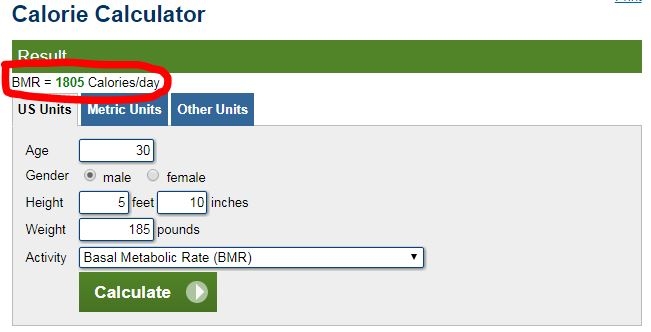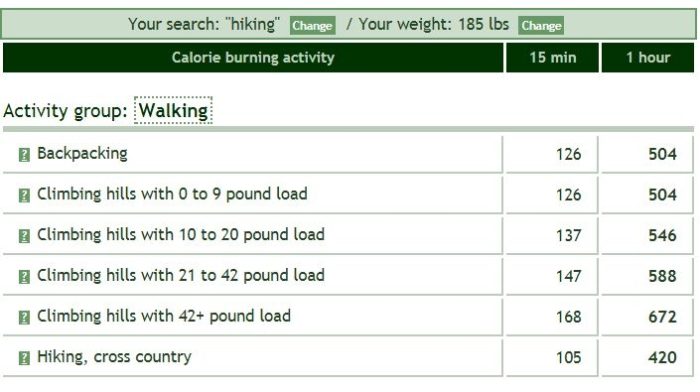Basic Thru-Hiker Nutrition Part 2: BMR and TDEE
In Part 1 of this series, I gave a brief overview of basic nutrition elements such as calories, carbohydrates, protein, and fat. In this segment, I will explain how to find your required daily food intake so that you can accurately estimate how much food you will need on the trail.
Basal Metabolic Rate
The focus of this segment will be on calculating your Basal Metabolic Rate, also known as your BMR. Calculating your BMR is a useful exercise because it helps to determine how many calories your body burns without any physical activity whatsoever. In other words, the number of calories your body needs for your organs, brain, and other crucial parts to operate. If you did nothing other than lay in bed all day and stare at the ceiling, your BMR is the number of calories you would need to stay at your current weight.
The easiest way to calculate your BMR is to plug in your age, gender, height, and weight into this calculator. Under “Activity”, make sure “Basal Metabolic Rate” is selected. Then, click “Calculate”. Here was my result:
According to the best calculations, my BMR is 1,805 calories. But since I’ll be hiking for multiple hours per day, additional calories are needed to replace those burned off during activity. This is where your Total Daily Energy Expenditure comes in.
Total Daily Energy Expenditure (TDEE)
Your Total Daily Energy Expenditure (TDEE) is your BMR adjusted for activity. It represents the total number of calories you need to sustain yourself given the amount of exercise you perform in a given day. This calculation is based on the Mifflin St. Jeor Equation, which multiplies your BMR by a number (1.1-2.5) depending on your level of activity. The problem with this calculation is that there is no setting for “thru-hiking”. The highest level of activity we can select on most calculators is “Extra Active”, which is doesn’t even come close to the energy exerted while thru-hiking.
These calculators were not built for those of us spending months on end in a constant state of physical stress, and thus any calculation of TDEE by this method is bound to be wildly inaccurate. Thankfully, there are other resources which can more accurately predict our caloric expenditure on the trail. I particularly like the calculator at CalorieLab because it shows information for various pack loads and dictates a burn rate per hour of activity. Here are my results:
According to this chart, my expenditure would be between 420 and 546 calories per hour. After an 8 hour day, I will have burned 3,360-4,368 calories in addition to my BMR! Of course this number depends on your weight and load, but I believe it to be quite accurate. I’ve run several ultramarathons (including a 53-miler that took me nearly 16 hours) and my measured expenditure has been between 550 – 800 calories per hour–and that’s with only a water pack! Suffice to say, you’ll be torching some major calories on the A.T.
Instead of using a TDEE calculator that is unable to consider the incredible feat of thru-hiking in its calculations, you’re better off calculating your BMR and then manually adding that to the calories burned by hiking, as shown above. Adding those two numbers together will yield the most accurate average caloric expenditure of your typical day on the trail. For me, this would come out to 1,805 (BMR) + 4,368 (546 x 8) = 6,173 calories per day. That is equal to 11 Big Macs. Is it any wonder that most people gorge themselves in hiker towns and still manage to lose weight along the trail?
Summary
This is by no means the end-all of nutritional calculations on the trail. Instead, the purpose of this exercise was to demonstrate how to estimate your caloric needs so that you’re not under-supplying or overfilling your pack on the trail. By using this calculator to estimate your BMR and then this one to calculate your calories burned per hour on the trail, you will have a much better idea of how much fuel you will be consuming (and, thus, need to be replenishing) on a daily basis on the trail.
In part 3, we’ll bring these concepts together to show how you might begin putting together a food plan for your thru-hike.
This website contains affiliate links, which means The Trek may receive a percentage of any product or service you purchase using the links in the articles or advertisements. The buyer pays the same price as they would otherwise, and your purchase helps to support The Trek's ongoing goal to serve you quality backpacking advice and information. Thanks for your support!
To learn more, please visit the About This Site page.




Comments 2
Great article and good points to consider. The link for the Calorie Lab no longer works.